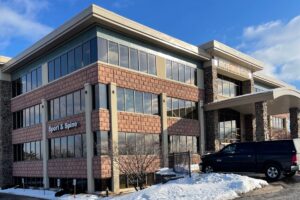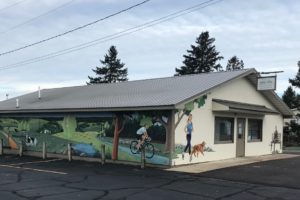Orthopedic Care
Pre-Op Education/Treatment
Orthopedic surgeons may refer patients to physical therapy prior to surgery. Surgeries such as knee and hip replacements, ACL, or rotator cuff repairs may require supplies such as a knee brace, sling, crutches, TED hose compression stockings, and cold therapy. The therapist will fit you with the appropriate assistive device, instruct you in proper use, and review any self-care activities including how to safely protect the healing body part, appropriate activity modification, dressing changes, and beginning home exercise program. We will also schedule your first post op appointment.
Occasionally your surgeon may prescribe a few sessions of physical therapy prior to surgery (called prehab) to help decrease swelling, improve range of motion or strength to improve the surgical outcome.
Arthritis/DJD
Arthritis and degenerative changes can affect many joints throughout the body. Some of the most common areas affected are the neck/cervical spine, low back/lumbar spine, and other weight bearing joints including the hips and knees.
Physical therapy for arthritis can focus on manual therapy and corrective therapeutic exercises to improve posture, range of motion, flexibility, and strength of affected joints. Various modalities such as heat, cold, ultrasound, vasopnuematic compression, and electrical stimulation can help with pain and swelling. Cervical and lumbar traction can be used to stretch/decompress the spine.
Occasionally off the shelf or custom braces are also used to add stability to the joints and decrease pain.
Low Back/Spine Conditions
There are many causes for low back, such as disc disorders, degenerative changes, stenosis, strains and sprains.
Physical therapy for lower back pain will be tailored to the individual patient and diagnosis. Interventions may include modalities such as heat, cold, ultrasound, and electrical stimulation to decrease pain. Manual therapy to also decrease pain, warm tissues, and improve tissue extensibility or range of motion. Therapy exercise is an important part of the recovery program, to improve range of motion, flexibility, and core strength. Occasionally mechanical pelvic traction is used to stretch/decompress the lumbar spine.
Back bracing is also available for more acute injuries or injuries where range of motion may need to be restricted.
For work-related injuries, therapeutic activities and self-care are used to condition the patient back to work and review proper body mechanics to protect the healing tissues and hopefully prevent reinjury.
Tendonitis
Tendons connect muscle to bone. Tendonitis is inflammation of a tendon. Tendonitis can cause pain, limited motion, and weakness around a joint resulting in decreased function.
Common area of tendonitis seen in physical therapy include: shoulder – involving rotator cuff and/or bicep tendons -commonly referred to as impingement syndrome, elbow – involving tendons connecting on the outside of the elbow – known as lateral epicondylitis or tennis elbow, or the inside of the elbow – known as medial epicondylitis or golfer’s elbow. Knee – involving the patellar tendon where it connects at the patella/knee cap – called jumper’s knee, and the Achilles tendon.
Physical therapy for tendonitis may include modalities to decrease pain or inflammation such as ultrasound, iontophoresis, electrical stimulation, cold therapy, or vasopnuematic compression. Manual therapy may be used to decrease pain and improve range of motion. Therapeutic exercise is then added to restore range of motion, flexibility, strength, endurance, stability, and function of the injured body part.
Surgical Repairs/Reconstruction/Post-Op Rehab
Patients are referred to physical therapy following many different types of surgeries. Some of the most common surgeries seen in our clinics include: rotator cuff, shoulder labrum repairs, total joint replacements, knee and shoulder arthroscopy, Achilles tendon repair, ACL and meniscus repairs, and fracture repairs/fixation.
Physical therapy following surgery will focus on decreasing pain and swelling, improving range of motion, strength, balance, weight bearing tolerance, restoring gait mechanics, or walking ability, and gradual return to functional and/or work-related activities.
Knee/Shoulder/Hip Rehab
There are many conditions and diagnoses that can affect the knee. Some of the most common seen in physical therapy include: patella femoral pain syndrome, degenerative joint disease, ligament sprains, patellar and iliotibial band tendonitis/jumper’s knee, ACL and/or meniscus repairs/reconstruction, and total knee replacement.
Physical therapy for knee injuries may include: bracing to protect healing tissues, provide stability, and decrease pain, manual therapy, corrective therapeutic exercise/activities to improve range of motion, flexibility, and functional strength, neuromuscular re-education to improve balance and stability. Various modalities such as ultrasound, iontophoresis, electrical stimulation, and vasopnuematic compression may also be used to decrease pain, improve tissue healing, and decrease swelling or inflammation. Physical performance testing may be used to determine if the patient is ready to return to their previous activity.
Shoulder pain and injuries are very commonly referred for physical therapy. Various diagnoses may include: impingement syndrome, rotator cuff tendonitis/bursitis, biceps tendonitis, labrum tears, instability, such as following a dislocation, frozen shoulder/adhesive capsulitis, fractures, and surgical conditions such as rotator cuff/labrum repairs, biceps tenodesis/tenotomy, shoulder arthroscopy, and shoulder replacement.
Physical therapy may include manual therapy and progressive therapeutic exercises to improve range of motion and strength. Neuromuscular re-education to improve stability. Therapeutic activities to improve function and return to work abilities. Various modalities may be used to decrease pain or inflammation, such as ultrasound, iontophoresis, electrical stimulation, or vasopnuematic compression.
The hip is a large weight bearing joint part of the lumbopelvic hip complex. Several muscles surround the hip joint, pelvis, thigh, and lower back areas. Possible hip injuries or diagnoses seen in physical therapy may include: bursitis, hip flexor/hamstring strains, labrum tears, and post surgical conditions such as total hip replacement or hip arthroscopy.
Physical therapy for hip pain or injury may include modalities such as ultrasound, iontophoresis, heat, cold, or electrical stimulation to decrease pain or inflammation, manual therapy and therapeutic exercise to improve range of motion, flexibility, and strength. Neuromuscular re-education and therapeutic activities are used to advance weight bearing tolerance, balance, and proprioception. Gait training may be involved if using assistance devices such as crutches, canes, or walkers.
Neck and Headache
Neck pain and injury can have various mechanisms of injury, including trauma such as a fall, motor vehicle accident, sports-related injury, or from gradual degeneration of the spine and postural changes. Diagnoses frequently seen in physical therapy include: degenerative/arthritic/disc-related conditions, stenosis, radiculopathy involving nerve irritation, and strains/sprains such as whiplash.
Because of muscular and ligamentous attachments from the neck to the skull, headaches are often a symptom associated with neck pain and injury.
Treatment for neck pain and headaches may include manual therapy to decrease pain and improve range of motion, dry needling, modalities such as ultrasound, moist heat, or cold, corrective therapeutic exercises and neuromuscular re-education to address postural changes, or cervical traction to decompress the spine.
Foot and Ankle Program
The foot is the first body part to hit the ground when we walk. As a result, foot and ankle injuries are very common. Some of the most common injuries seen in physical therapy include: plantar fasciitis, Achilles tendonitis, ankle sprains, tendonitis, and post-surgical care following ligament reconstruction or fracture repair.
Treatment for foot and ankle injuries may include modalities such as ultrasound, iontophoresis, or vasopnuematic compression to decrease pain, inflammation, or swelling. Manual therapy is used to improve range of motion, therapeutic exercise is often a key component to address flexibility or postural issues such pronation. Therapeutic activities and neuromuscular re-education are used to advance weight bearing, functional activities, balance, and proprioception.
Clinicians may also use ankle braces, custom orthotics, or other assistive devices such as crutches or canes as needed. Gait training may be needed to improve weight bearing status and walking mechanics.



